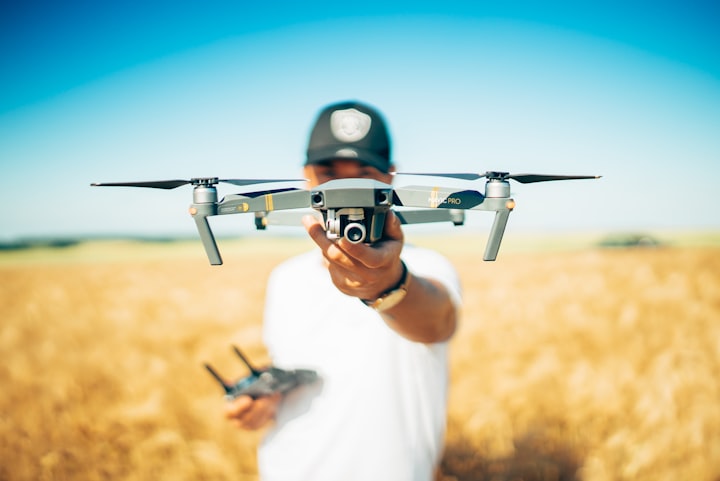How Drones Help In Crop Production Services and Improving Production Yield in Agriculture
How Drones Help In Crop Production Services

Technology's quick and flexible nature helps its applied industries advance and become more convenient. Unmanned aerial vehicles (UAVs) and drone technology have made incremental progress possible in these applications, saving money and time.
Drone use in the agricultural sector performs a variety of tasks, including:
● Terrain Mapping
● Land Inspection
● Aerial Surveillance
● Crop Monitoring
● Fertilizer Spraying
● And many more
Many drone types are the most innovative in farming, horticulture, and agriculture. The innovation of modern drones assists in better crop production services.
But why is it essential to have efficient crop production for farmers? How can drones help us with sustainable farming and production?
Defining the Significance of Crop Production Services
Why is it vital for us to establish effective crop production? How does that impact society?
The answer to these questions is the increasing global demand for food, materials, and economy. One of the core sub-fields of agriculture is crop production. Producing crops provides the foundation for feeding the people and supplying feed to the animal business.
Amid challenging circumstances, agricultural firms must implement innovations to increase production effectiveness. Farmers face the challenges of applying for loans, high costs for crop yield, and getting fertilizers.
Modern innovations such as agricultural drones contribute to improved crop production. There are different types of drones available in the market. Farmers can choose a variety of UAVs to fit their farming requirements.
The Products of Crop Production
The crop production service manufacturer’s good fall into these groups, including:
#1. Food
Cereal and oat goods are a few examples of food items from crop grains. Some crops get turned into feed for animals, which they subsequently consume. These animals usually produce dairy, poultry, and meat products. Other examples of food items are honey and farmed fish.
#2. Natural Resources
The goods that haven't been refined or otherwise prepared for use are natural resources for numerous products. Many cultivated crops turn into food for livestock and create other agricultural goods.
#3. Fuel
Agricultural crop production also creates fuel. The most widely used crop fuel is ethanol, made from maize, sugarcane, or sorghum.
#4. Textile
Crop production includes wool, silk, and cotton, among the most popular fibers. Meanwhile, farmers use hemp and flax to create rope and linen. Bamboo fibers are also materials for producing articles of clothing.
Four Vital Applications of Agricultural Drones in Contributing to Better Farming Yield
Farmers that use agriculture drone services may better manage their crops and animals by using effective crop production services.
Drones offer photographic and video data for farming, instantly scanning broad land tracts to determine where it needs attention. Drones provide real-time soil, plant, moisture, and topography input to maximize output, reduce waste, and boost profits.
These agriculture drones provide services for better crop production, such as:
1. Even Fertilizer Distribution
Drones' ability to move quickly and navigate to desired areas makes them essential for more efficient crop production. Drones with this capability may spray pesticides and fertilizers to nourish crops and provide them with the nutrition they require. Crops can be healthy and prosper with the help of such supplements.
UAV pilots can watch while the drone sprays nutrients to ward off pests, worms, and insects and lengthen crop life. Drones' capacity to fly makes it easier to spray fertilizers and pesticides for better growth and acquiring necessary nutrients. Crops can be healthy and prosper with the help of such supplements.
2. Straightforward Seeding Process
Agriculture is a very labor-intensive and time-consuming sector. Mainly because it takes a long time, seeding necessitates human work. UAV technology offers a straightforward crop production service when it comes to seeding. Drones with specialized features can sow seeds faster and more efficiently.
3. Monitoring Soil Condition
Drones' powerful powers aid in the rudimentary process of determining soil health. UAVs gather and analyze data that are vital to examine, manage, and maintain the health and composition of the soil. Drone technology may also supply the earth with nutrients to boost its health and well-being. Drones carry out this soil health analysis through 3D mapping and data processing processes.
4. Analyzing Any Possible Issues
Drones' ability to evaluate, diagnose, and inspect crops for any inadequacies is another fantastic benefit of utilizing them for fertilizing. Their laser-equipped high-resolution cameras and sensors also aid in completing these tasks fast. UAVs gather data and analyze them to create other crop-related decisions. UAVs can map these inadequacies in real time as well.
Agricultural Drones: Creating Dynamism in the Farming Industry
Drone technology may help you surpass your harvest targets and generate more crops with fewer resources. It doesn't matter whether you're a leader of a huge corporation or an independent farmer. Effective crop production services are fundamental ways that the appropriate UAV and payload may assist.
Drone technology exposes nearby fruit trees' plant diversity, vigor, and state of health. Unmanned aerial vehicles can, therefore, greatly facilitate and support crop production.
About the Creator
Lori Gillen
Lori Gillen is a Blogger/Content Creator who is specialized in the field of Digital Marketing & Data Analysis with 5 years of experience. Currently working at ChartExpo as a Senior Content Creator.






Comments
There are no comments for this story
Be the first to respond and start the conversation.